Since 1891, Puget Sound Naval Shipyard and Intermediate Maintenance Facility (PSNS & IMF) has built and supported vital naval assets through two world wars and several conflicts, many technological changes, as well as fluctuations in our nation’s economy. Through adaptability, perseverance and devotion to duty, the facility has maintained its reputation as a provider of world-class service to all U.S. Navy vessels.
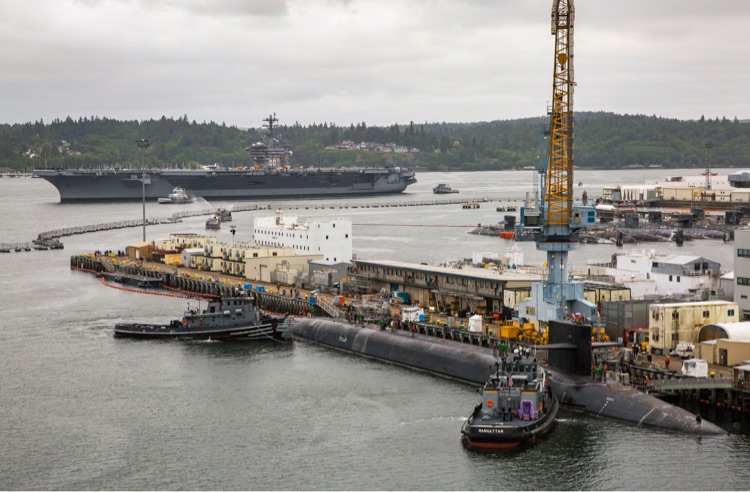
PSNS & IMF is the Navy’s primary provider for the maintenance, repair, modernization, inactivation, and recycling of ships, submarines, and aircraft carriers in the Pacific Fleet. PSNS & IMF is the only Navy shipyard on the West Coast with a dry dock that can accommodate nuclear-powered aircraft carriers for repair and maintenance. Additionally, PSNS & IMF is the only Navy shipyard that is approved to recycle nuclear-powered submarines.
Much of the infrastructure at PSNS & IMF dates back to the late 1800s and early 1900s and it was primarily designed for building and maintaining ship classes that are no longer part of the modern naval fleet. Other than construction of Dry Dock 6 in the early 1960s, the shipyard has had few major infrastructure updates since the mid-1900s, which has led to significant production inefficiencies for maintaining current ships. The shipyard lacks the necessary capacity to accommodate new and future classes of ships.
The U.S. Navy’s Proposed Action is to construct a new multi-mission dry dock at PSNS & IMF. The proposed dry dock would be designed and built to serve multiple missions and therefore would be classified as a multi-mission dry dock. The Proposed Action includes the demolition, replacement, and/or construction of other piers, wharves, moorings, cranes, and building and support facilities, including a new forge shop and expanded Radio Hill complex at Naval Base Kitsap-Bangor. The Proposed Action would include dredging to create adequate water depth at wharves and piers and as required for construction of new structures.
The Notice of Intent published in June 2022 included several projects that are no longer part of the Proposed Action. Pier 5 demolition, Pier 6 replacement, and Dry Dock 6 seismic upgrades are not currently funded or programmed for implementation, and a future construction schedule has not been determined. If the Navy decides to proceed with these potential projects at a later date, the Navy will analyze potential environmental impacts in accordance with NEPA requirements.
PSNS & IMF is located at Naval Base Kitsap-Bremerton, which is on the north side of Sinclair Inlet within the city of Bremerton in Kitsap County, Washington.
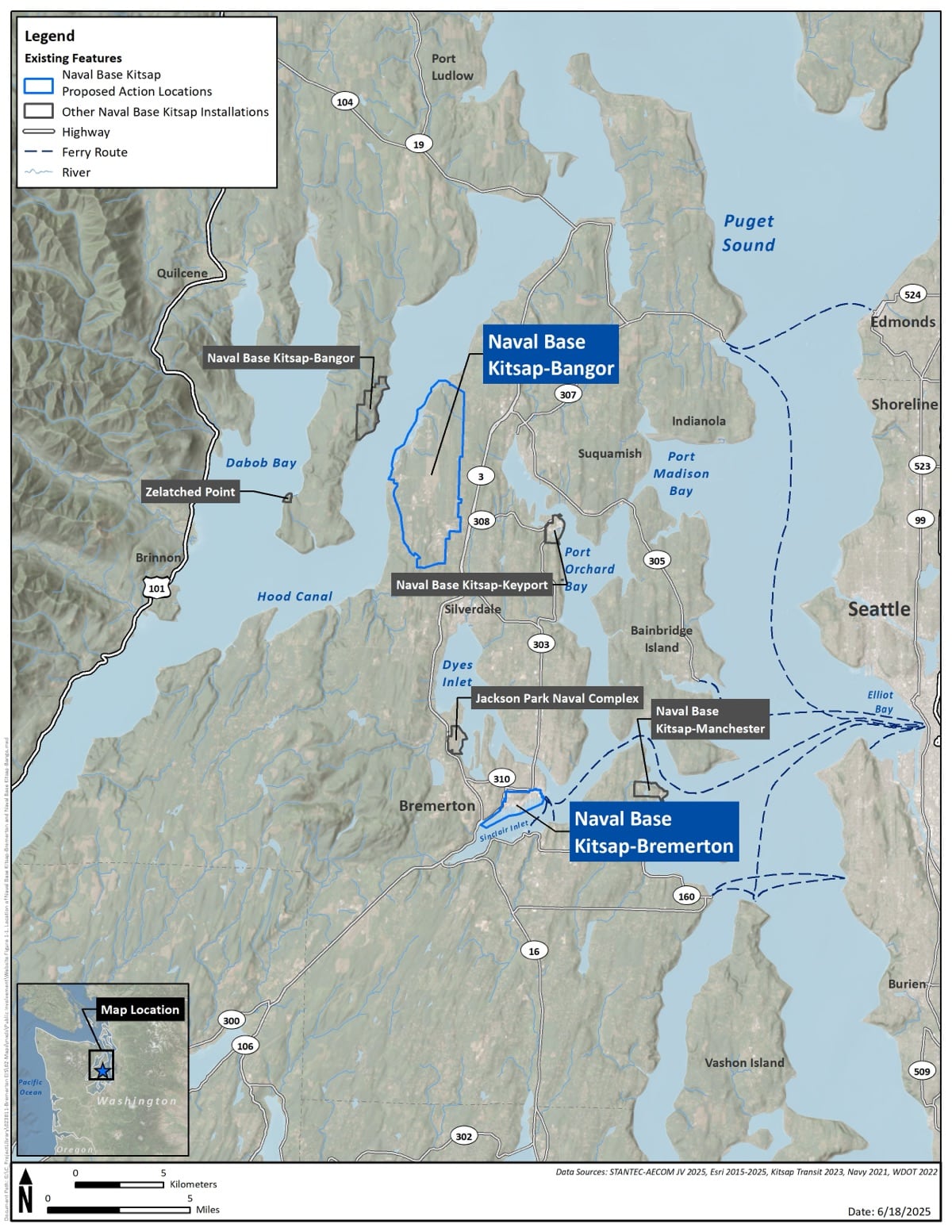
The purpose of the Proposed Action is to address critical deficiencies in dry dock capability, capacity, and seismic survivability at Naval Base Kitsap-Bremerton to enable PSNS & IMF to meet its mission to support the Navy’s nuclear fleet.
The Proposed Action is needed because:
A new multi-mission dry dock and associated waterfront infrastructure improvements are necessary to provide the capacity and capability to meet the Naval fleet’s future operational needs.
The Navy considered numerous alternatives to meet its purpose and need. Alternatives that met the purpose and need were evaluated against screening criteria. Two action alternatives are currently under consideration in addition to the No Action Alternative. Alternative 2 is the Navy’s Preferred Alternative.
| Feature | Alternative 1 No Action Alternative |
Alternative 2 (Preferred) Multi-Mission Dry Dock at Dry Dock 3 |
Alternative 3 Multi-Mission Dry Dock at Mooring A |
|---|---|---|---|
| Multi-Mission Dry Dock Location | No multi-mission dry dock constructed | Dry Dock 3 | Mooring A |
| Multi-Mission Dry Dock Wharf | No multi-mission dry dock constructed | New nuclear-powered aircraft carrier repair wharves, including Wharf 6 at multi-mission dry dock west wall and Wharf 7 at multi-mission dry dock east wall | New nuclear-powered aircraft carrier repair wharf (Wharf 2) at multi-mission dry dock east wall |
| Moorings E, F, and G | No change | No change | Modify to store inactivated ships from Mooring A |
| Forge Shop | No change | New forge shop at Naval Base Kitsap-Bangor | No change |
| Parking Garage | No new parking garage | No new parking garage | Construct a new parking garage |
| Pier 2 | No new Pier 2 constructed | Construct new Pier 2 | No new Pier 2 constructed |
| Pier 4 | No change | Demolish and replace with new pier | Demolish and replace with new pier |
| Pier 6 | No change | New Wharf 6 at multi-mission dry dock west wall | No change |
| Hammerhead Crane | No change | Deconstruct and remove | Deconstruct and remove |
| Building 460 | No change | Demolish and replace | No change |
| Pier 7 | No change | New Wharf 7 at multi-mission dry dock east wall | No change |
| Former Pier 8 | No change | Remove select pile foundations | No change |
| Mooring A | No change | No change | Demolish |
| Dredging | No dredging | Dredge to create adequate depth at wharves and piers and to accommodate construction of new structures | Dredge to create a new turning basin and to accommodate construction of new structures |
| Building Demolition and Replacement | No change | Building demolition and replacement | Building demolition and replacement |
| Radio Hill Complex | No change | Expand Radio Hill complex | Expand Radio Hill complex |
Under the No Action Alternative, the proposed multi-mission dry dock would not be constructed, and other component actions would not occur. The Navy would continue to maintain, repair, and operate existing facilities, but would continue to experience production inefficiencies due to the shipyard’s limited capacity and capabilities for servicing current and future ships.
The No Action Alternative does not meet the purpose and need for the Proposed Action, but as required by NEPA, the No Action Alternative is analyzed to provide a baseline for measuring the environmental impacts of the action alternatives.
Under Alternative 2, the Navy would:
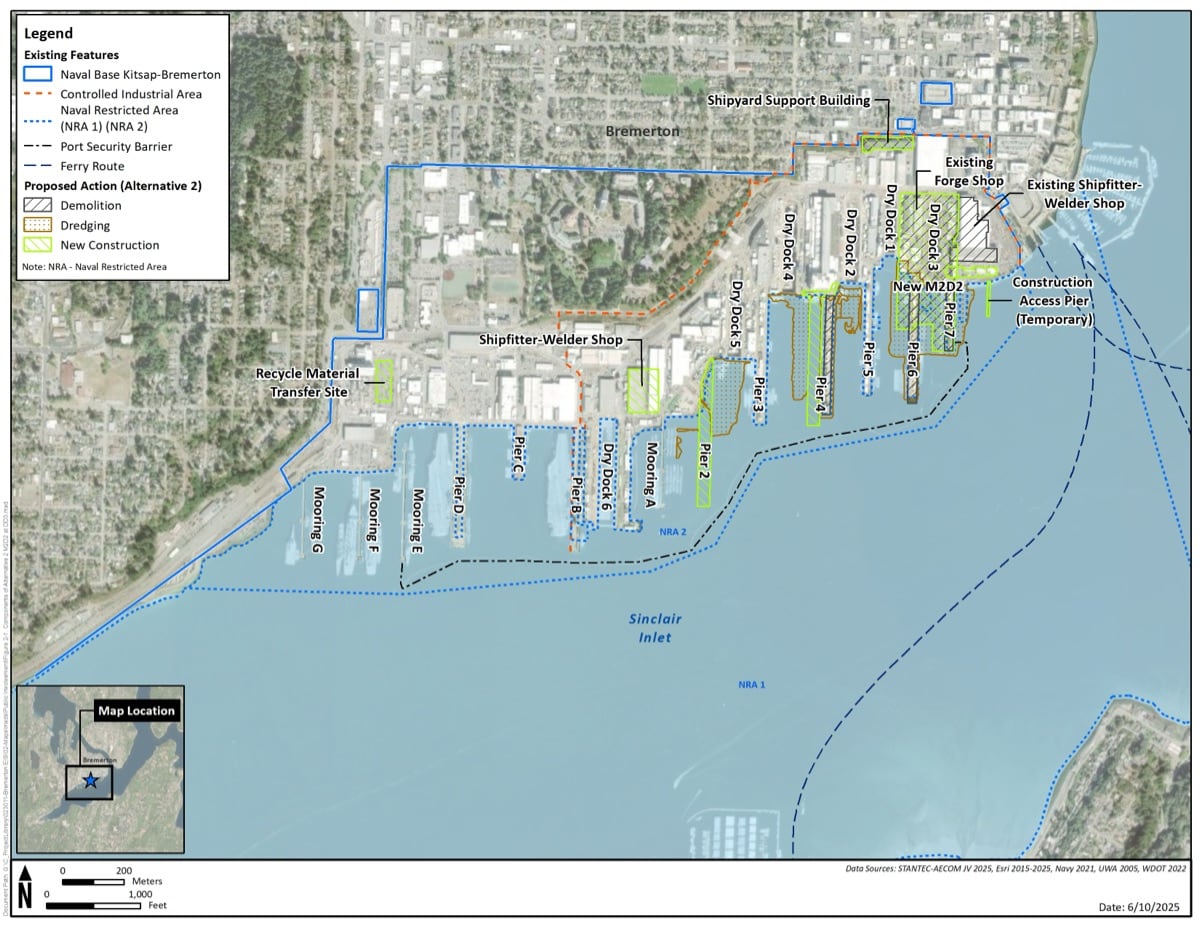
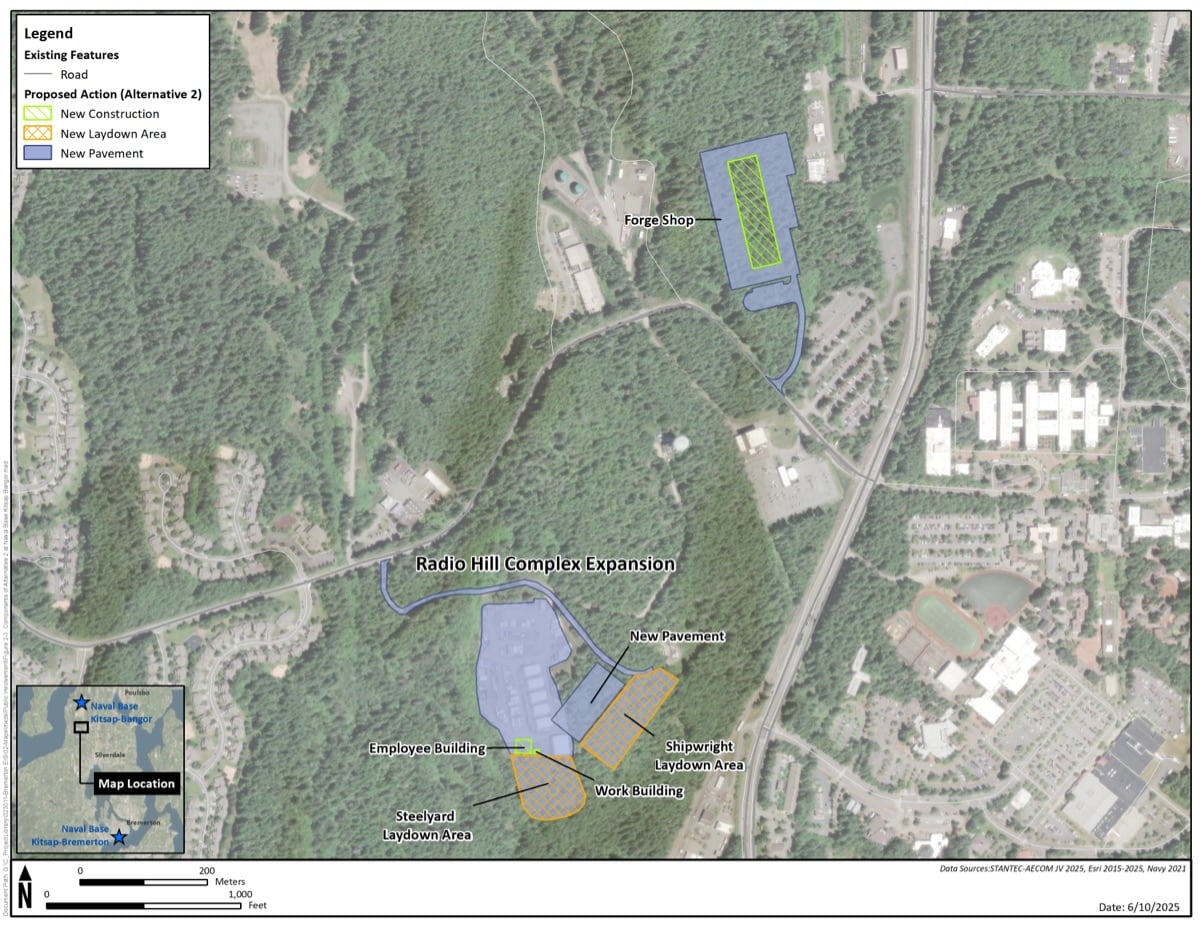
Under Alternative 3, the Navy would:
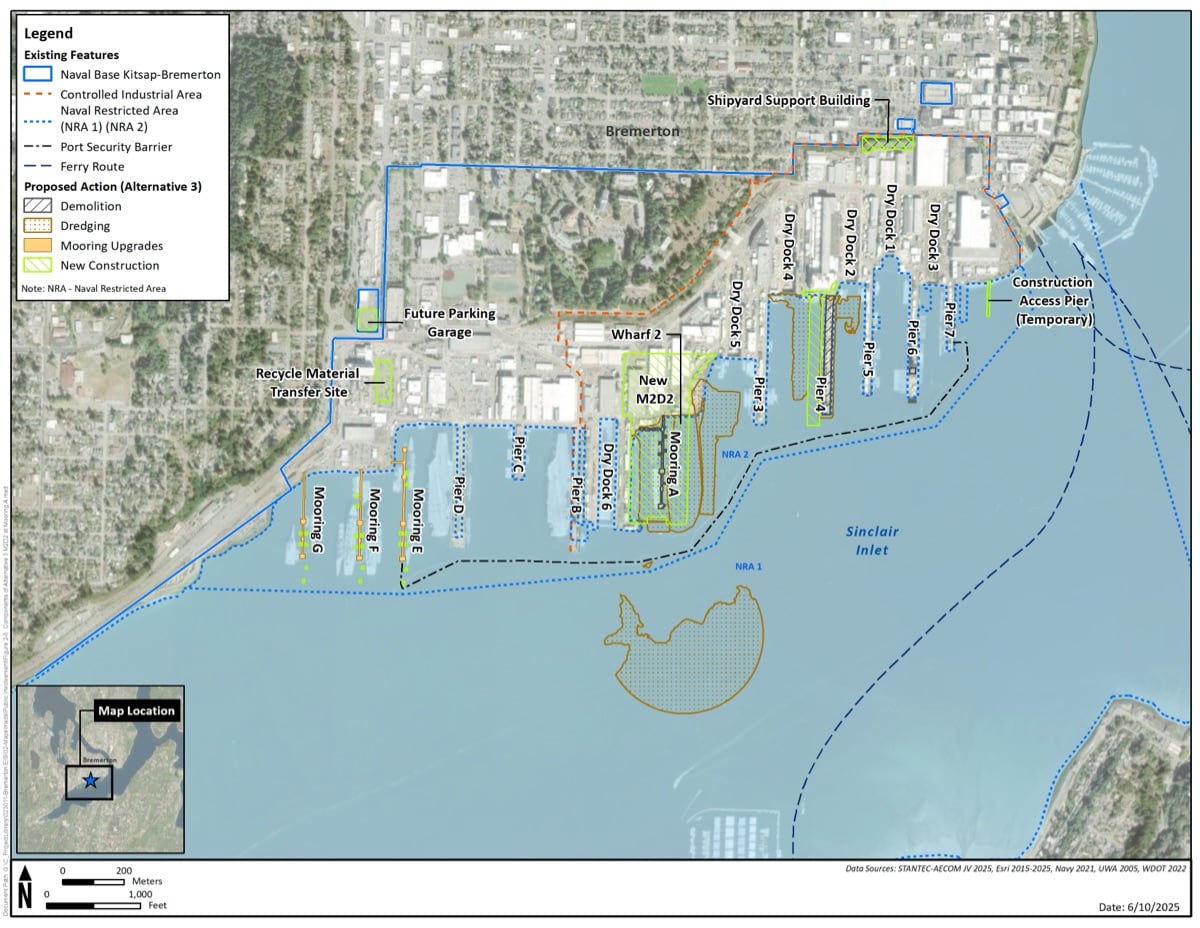
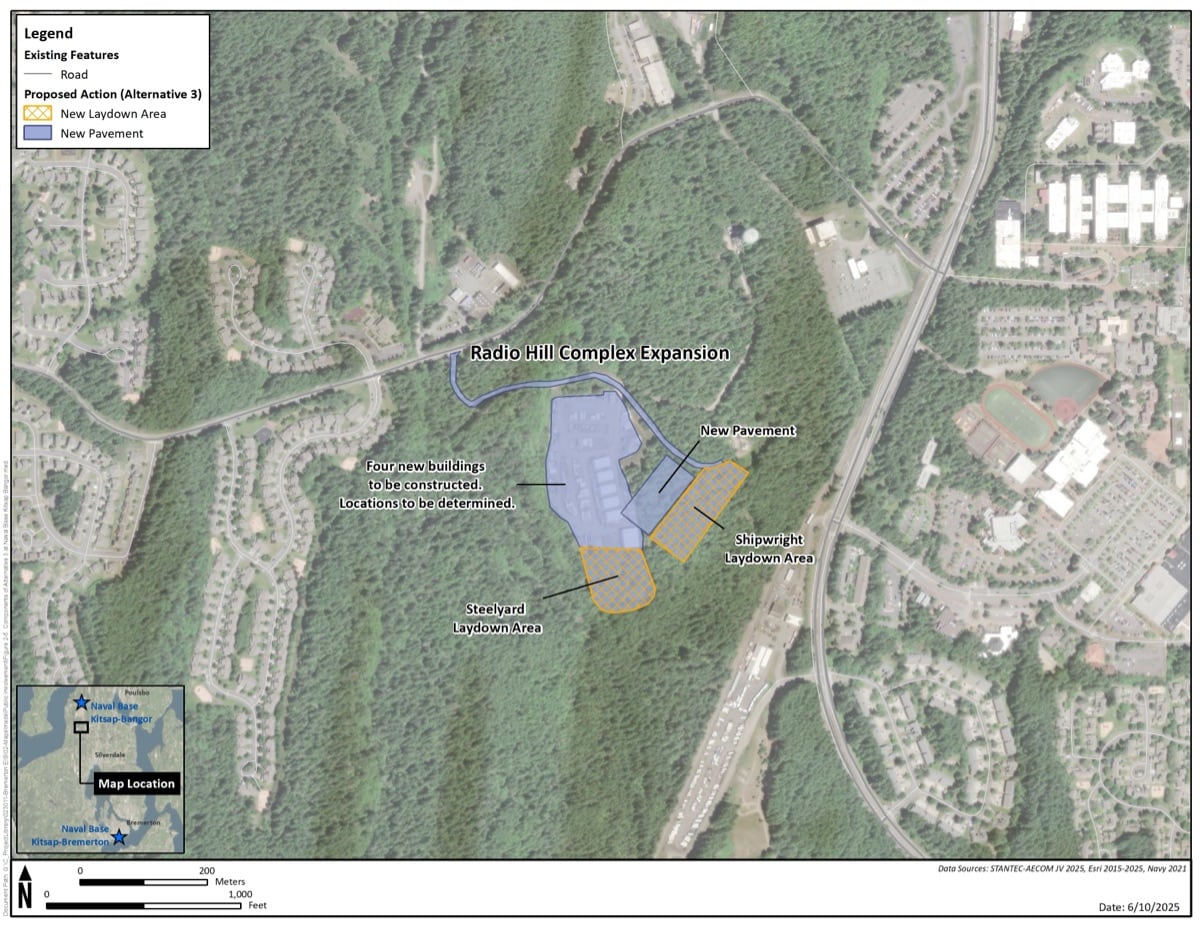
The U.S. Navy analyzed the potential impacts to the Proposed Action and alternatives on the environmental resource areas listed below.